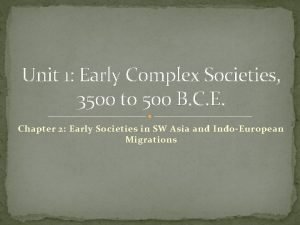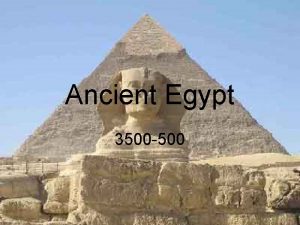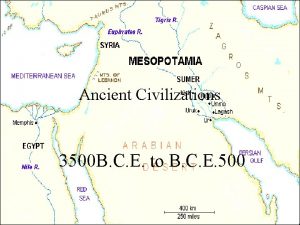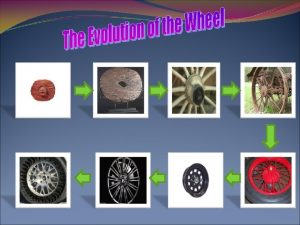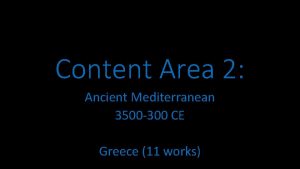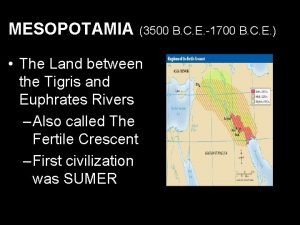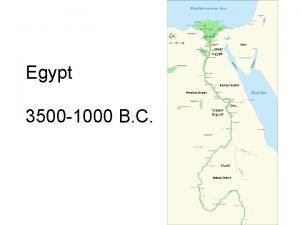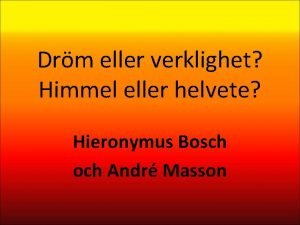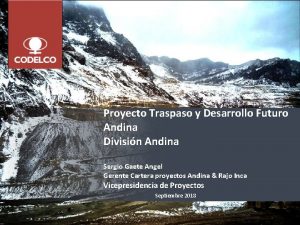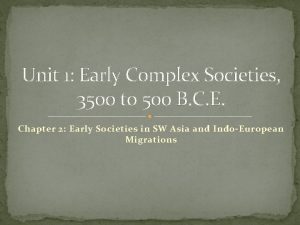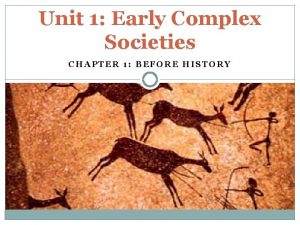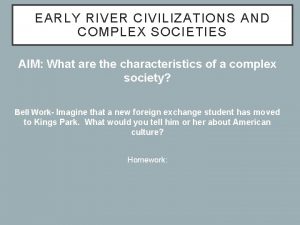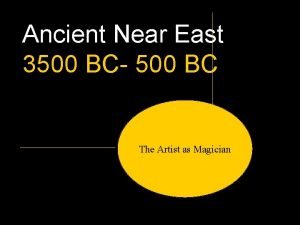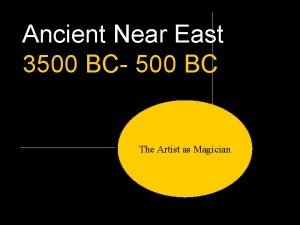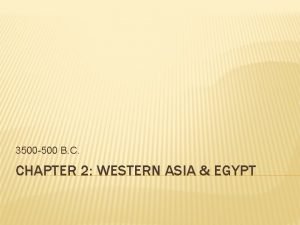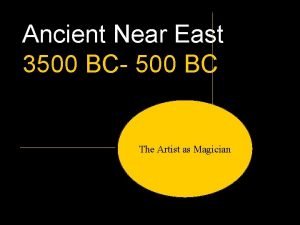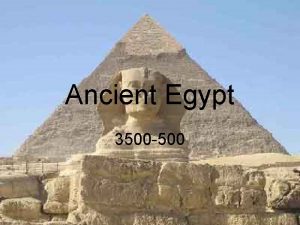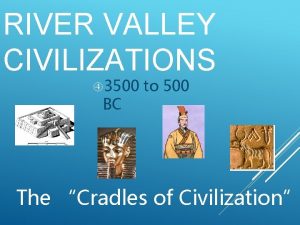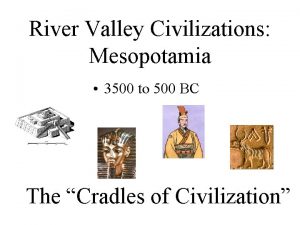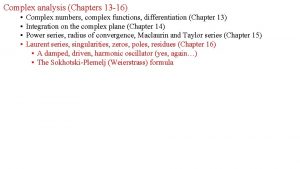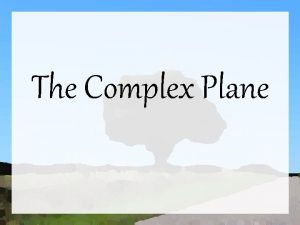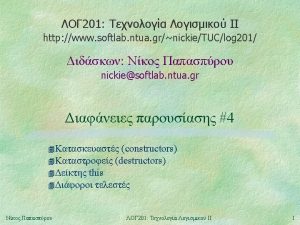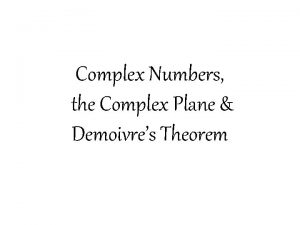Unit 1 Early Complex Societies 3500 to 500


























- Slides: 26

Unit 1: Early Complex Societies, 3500 to 500 B. C. E. Chapter 2: Early Societies in SW Asia and Indo-European Migrations

Civilization Defined �Urban (a. k. a. cities) �Political/military system �Social stratification (social classes) �Economic specialization (different jobs available) �Religion �Communications (writing or other) �“Higher culture” (art, literature, etc. ) �Key issue: irrigation � Necessity of coordinated efforts � Promoted development of local governments � City-states 2

Mesopotamia Fertile Crescent

� Mesopotamia � “Land between the rivers” � Sumer � Tigris & Euphrates � little rain = need for irrigation (small scale by 6000 B. C. E. ) � Sumerians were dominant people � Sumer = Southern ½ of Mesopotamia � Semitic Migrants � Sumerian City- States � Irrigation networks = abundant harvests = pop. Increase (by 3000 BCE close to 100, 000 ppl) � Sumer wealth attracted migrants � Sumerians built 1 st cities � cities were political, economic, & cultural center of larger region. � (i. e. political = extending authority/military power, economic = marketplaces/trading, cultural = schools/temples to spread traditions/values)

� Sumerian City- States https: //www. youtube. com/watch? v=2 Odv. SB ydmk. Q (16: 20 – 24: 00) � Governments preserved peace & sponsor building projects and irrigation � Attacks lead to wall building & military development � Ziggurat home of god (temple) � Kingships Evolve � Earliest gov’t = prominent men making decisions for all community � By 3000 BCE, all Sumerian cities � Empire emerges had kings w/ absolute authority (monarchy). � To stop constant conflicts w/ neighboring ppls, conquerors united large areas

Mesopotamian ziggurat

�Sargon of Akkad �(2370 -2315 B. C. E. ) � Traveled w/ army; destroyed Sumerian states one by one, created empire based in Akkad � Seized trade routes & natural resources (builds resentments) � Empire unable to contain chronic rebellions �Hammurabi and �(1792 -1750 B. C. E. ) Babylonian Empire � Centralizes bureaucracy and regulates taxation � Used local governors to maintain control of city-states � Law Code: law of retribution (lex talionis) �importance of social status � Hittites attack empire crumbles in 1595 B. C. E.

�Later Mesopotamia n Empires �Assyrian Empire �New Babylonian Empire �Assyrians (northern Mesopotamia), about 1300 -612 B. C. E. � Cities: Assur and Nineveh � Powerful army - horse-drawn chariots, archers, iron weapons � Internal unrest (unpopular rule) & external assault = end in 612 B. C. E. �Also called “Chaldean Empire, ” 600 -550 B. C. E. � Nebuchadnezzar (605 -562 B. C. E. ) � Hanging gardens shows wealth/luxury � Foreign conquerors added to their empire (c. 550 BCE)

Mesopotamian Empires, 1800 -600 B. C. E. 9

� Formation of complex society & sophisticated cultural traditions �Economic specialization and trade �Bronze (copper with tin), c. 4000 B. C. E. � Military, agricultural applications �Iron, c. 1000 B. C. E. � Cheaper, more widely available than bronze �Wheel (c. 3500 B. C. E. ) helps trade; carts carry more goods further �Shipbuilding - maritime trade increases in all directions; network develops (3500 B. C. E. )

�Cities = more opportunities to accumulate wealth �Social Classes �Ruling classes based often on military prowess � Perceived as offspring of gods �Religious classes (priests) � Role: intervention with gods to Kings/Nobles Priests/Priestesses Free Commoners & Dependent Clients Slaves ensure good fortune for community � Considerable landholdings, other economic activities �Free commoners � Peasant cultivators � Some urban professionals �Slaves � Prisoners of war, convicted criminals, debtors

� Patriarchal Society � Men as landowners, relationship to status � Patriarchy: “rule of the father” � Right to sell wives, children � Double standard of sexual morality � Women drowned for adultery � Relaxed sexual behaviors for men � Women’s Roles � Some possibilities of social mobility for women � Court advisers, temple priestesses, economic activity � Women = fewer rights after 2000 B. C. E. � Wear veils to discourage attention at least c. 1500 B. C. E. � Married women = No socializing w/ men outside family � Virgin brides

� Development of written cultural traditions � Education � Sumerian invent writing (4000 BCE) for commercial transactions, tax collections � Cuneiform = “wedged-shaped” w/ reed stylus and clay tablets � Education: vocational to be scribe or government official � Literacy = rapid expansion of knowledge � Astronomy and Mathematics � To help w/ harvests � Mesopotamian scientists divided year into 12 mos. and hours into 60 secs.

�Epic of Gilgamesh �Explored themes of friendship, relations b/t humans & gods & meaning of life and death �Gilgamesh written as a god/godlike �Heroic saga �Search for meaning, especially afterlife

�Broader influence of Mesopotamian society �Hebrews, Israelites, and Jews �Early Hebrews are pastoral nomads between Mesopotamia and Egypt (2000 B. C. E. ) �Settle in cities �Abraham leads group to Palestine 1850 B. C. E. (“founder” of Judaism) �Descendants borrow laws from Mesopotamia (lex talionis) �Some migrate to Egypt in 1700 B. C. E. where they are enslaved, then back to Palestine with Moses

Moses and monotheism �Moses introduced monotheism, belief in one god � Denied existence of competing parallel deities (gods) � Personal god: reward and punishment for conformity with revealed law � Ten Commandments: moral and ethical standards for followers � Torah (“doctrine or teaching”) – Jewish holy book �Mesopotamian-style monarchs - http: //www. youtube. com/watch? v=f. AJ 6 d. BXb. Ivs David (1000 -970 B. C. E. ) then Solomon (970 -930 B. C. E. ) - with Jerusalem as capital

�Assyrian Conquest �Assyrians conquer Israel in north; Judah in south & destroy Jerusalem �Deportees return to Judea; become known as Jews (586 B. C. E. ) �Prophets increase devotion of people & build distinct Jewish community with strong group identity

� Phoenicians � City-states along Mediterranean coast after 3000 B. C. E. � Extensive maritime trade � Dominated Mediterranean trade, 1200 -800 B. C. E. � More interested in commercial (trade) opportunities than state building or military expansion � Little agriculture; live on industry and trade (excellent sailors) � Colored textiles (dye) & cedar wood � Alphabet � Created early alphabetical script (1500 B. C. E. ) � 22 symbols = consonant sounds � Easier than cuneiform � More people became literate

Phoenician Alphabet

Phoenician Alphabet

Israel and Phoenicia, 1500 -600 B. C. E. © 2011, The Mc. Graw-Hill Companies, Inc. All Rights Reserved. 21

� Indo-European origins Migrations � Linguists discover similarities between many languages = must be related � Originated in steppes of central Asia (Ukraine & Southern Russia) � Pastoral people; 4500 -2500 B. C. E. � Horses � Domesticate horses; learn to ride; use horses with carts, then chariots � Travel, transport over long distances � Tremendous military advantage � Indo-European expansion and its effects � Indo-European society breaks up about 3000 B. C. E. ; peoples gradually migrate

� Indo-European � East � Tarim Basin (western China) Migrations � West � Greece, Italy, central Europe, western Europe, Britain � South � India � Commonalities � Honor similar of Indo. Europeans deities � Related languages � Pastoral agriculturalists � 3 main social groups: (1) military ruling elite, (2) small group of priests, (3)large class of commoners

Indo-European Languages Majority of people are native Indo – European speakers Have Indo-European language with official status

Indo-European Migrations 3000 -1000 B. C. E. © 2011, The Mc. Graw-Hill Companies, Inc. All Rights Reserved. 25

�Hittites settle in central Anatolia (Turkey) 2000 B. C. E. � Build powerful kingdoms � Close relations w/ Mesopotamian peoples � Conquer Babylonian empire 1595 B. C. E. � Dissolve by 1200 B. C. E. �Technological Innovations (1) light horse- drawn chariots (spokes) (2) iron metallurgy
 The early complex societies 3500 to 500 b.c.e
The early complex societies 3500 to 500 b.c.e 3500 / 500
3500 / 500 Early cpr and early defibrillation can: *
Early cpr and early defibrillation can: * Bruno dislikes sitting on the beach
Bruno dislikes sitting on the beach Ghon complex
Ghon complex Simple compound complex and compound-complex sentences quiz
Simple compound complex and compound-complex sentences quiz The electra complex
The electra complex Module 55 psychoanalytic and psychodynamic theories
Module 55 psychoanalytic and psychodynamic theories Mbti percentages
Mbti percentages Tronic heat 3500
Tronic heat 3500 3,500 bce
3,500 bce 3500 bc wheel
3500 bc wheel Philips lbb 3500
Philips lbb 3500 Athenian agora map
Athenian agora map Bosch tronic heat 3000/3500
Bosch tronic heat 3000/3500 3500 + 1700
3500 + 1700 1000 bc egypt
1000 bc egypt Comp3500
Comp3500 Comp 3500
Comp 3500 Ts 3500
Ts 3500 4000000/3500
4000000/3500 Mesopotamia floodplain
Mesopotamia floodplain Bosch tronic 3500
Bosch tronic 3500 Aironet 3500 presentations
Aironet 3500 presentations Nodo 3500 andina
Nodo 3500 andina 3500/3000
3500/3000 Unit 10, unit 10 review tests, unit 10 general test
Unit 10, unit 10 review tests, unit 10 general test
